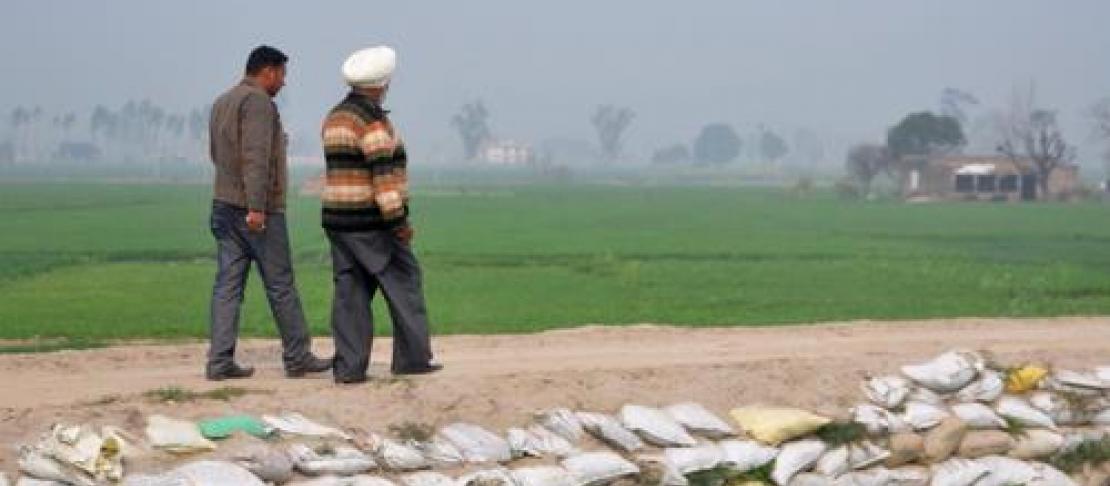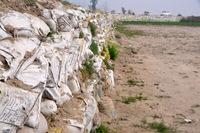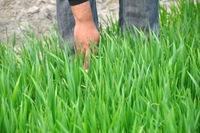About adaptation, mitigation, floods and the need for information

Climate change adaptation and mitigation in agriculture is more than merely “the need for better seeds”. It needs a way to exchange information so we can re-apply proven solutions rather than re-inventing the wheel every single time….
In a wide, slow gesture, Gurbachan Singh shows me a panorama of lush fields. It is as if he hand touches the abundant, young wheat sprouts from afar. They are bright green, showing a promise for a plentiful harvest. Wide fields are bordered with tall poplar trees whose leafs softly whisper in the light wind, chasing away the early morning mist.
“All of this”, says Gurbachan, “All of this was gone. Flooded. As far as you can see. All of it. People had fled to higher grounds, but the twenty-four hours notice we had before the flood, was not sufficient to evacuate all live stock. Most buffalo and cows drowned. The harvest was lost.”
 We are standing near the village of Bhoda in Punjab, North West India. From a large dike, made of sandbags, probably five metres (15 ft) high, we see the river, flowing slowly beneath us. It is hard to imagine that in July last year, this small stream had swollen with a mighty force, digging a hole in the dike, half a mile long.
We are standing near the village of Bhoda in Punjab, North West India. From a large dike, made of sandbags, probably five metres (15 ft) high, we see the river, flowing slowly beneath us. It is hard to imagine that in July last year, this small stream had swollen with a mighty force, digging a hole in the dike, half a mile long.
“Remember the massive floods in Pakistan, around August last year?”, asks Gurbachan, “Well, we are up river from them. When the unusual strong monsoon rains, came streaming down from the mountains, it hit us a month earlier. We hardly had time to tell everyone to move. The dike burst in no time. As soon as there was a hole in the dike, water just streamed through. In a few hours, everything you see here, all the way to the horizon, was all flooded.”
And the water kept coming. With the help of an engineer, the villagers made an emergency dam with tens of thousands of sandbags. “The government promised they would rebuild the permanent dike, but we are still waiting. The sandbags were supposed to be a temporary measure. They are only filled with sand. The sun consumes the bags, so the sand leaks out of it.”
 A dozen villagers have joined us, injecting comments into the discussion... Their voices are loud and angry. “We get no help from the government”, they argue, “All their promises don’t mean a thing. By the next monsoon, five months from now, these sandbags will wash away. We need a proper dike, lined with stones. We should plant trees on it so the roots can hold the dike together.”
A dozen villagers have joined us, injecting comments into the discussion... Their voices are loud and angry. “We get no help from the government”, they argue, “All their promises don’t mean a thing. By the next monsoon, five months from now, these sandbags will wash away. We need a proper dike, lined with stones. We should plant trees on it so the roots can hold the dike together.”
But it is not just here, in Bhoda, where the dike is fragile. All along the river for tens of miles, the river edges are low, leaving large areas prone to flooding. “Even if flooding might be stopped here, dikes anywhere else might break. And each flood will take dozens of animals with it, and destroy the crops of entire villages in a few hours time“, Gurbachan argues.
“Next year, it might even be worse”, another villager warns, “If the weather keeps on changing, and the rains continue to get heavier, maybe next year, we will not get a 24 hours notice before the flood waters hit us. Maybe the flood will be higher; maybe we will have a flood like in Pakistan, where entire provinces were wiped out. And then? Who will help us then?”.
 And then something I have heard during many interviews with farmers in India: “The risk of farming has become too big”, says one of the village elders, “The cost and efforts we have to do, to earn a living have become too high. But the worst is, we know that we might lose our entire crop in the next flood. We know the risk is high. So every day we work on the fields feels like it is a day of efforts in vain," says another farmer. Others agree: “This is no future for our children.”
And then something I have heard during many interviews with farmers in India: “The risk of farming has become too big”, says one of the village elders, “The cost and efforts we have to do, to earn a living have become too high. But the worst is, we know that we might lose our entire crop in the next flood. We know the risk is high. So every day we work on the fields feels like it is a day of efforts in vain," says another farmer. Others agree: “This is no future for our children.”
“You should help us”, another elder says, “You should tell our story to the people. We need proper protection against the floods. If the government cannot help us, we should take matters in our own hands. So tell the story, maybe things will change. Maybe someone knows how to avoid this flooding. The weather, we can not change, but you can help us protect our crops, our lives!”
That is why I wrote the story. It shows that climate change adaptation and mitigation in agriculture is not only an issue of finding adapted seed varieties, teaching better irrigation methods and finding new fertilizer application techniques. Assisting farmers to cope with the challenges covers a wide area, and many aspects.
Above all, this flood story shows the need to be able to find and exchange the information. I am not an infrastructural specialist, nor a flood mitigation engineer. But I would assume that someone “out there” has worked in a flood prone area, and found a solution, other than building tens of miles of dikes, which might only move the flooding problems further downstream…
So where are these experts? How can we re-apply their knowledge? These are some of the challenges we, at CCAFS, are trying to tackle. Watch this space,… more coming soon!
The way ahead for researchers and smallholder farmers facing current and coming challenges posed by climate change lies in learning from each other while sharing knowledge and experiences.
Photo in this article by Peter Casier.

